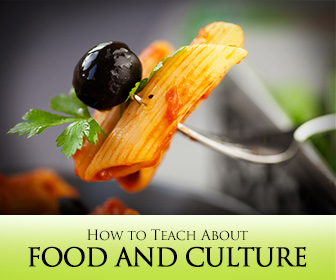
Before diving into this topic, a disclaimer: this project basically requires a kitchen.
You can do it without one, but you will have to choose you recipes very carefully and it may limit the choices you have of cultures to encapsulate. Further, this is designed for use in camps where a teacher has the same students for about half a day. It can work with normal class schedules, but it stretches over a much longer period.
So you have a kitchen area and the time to take on this project, fantastic! Students of all ages love food. Heck, most teachers love food. As ESL teachers, part of our role, at least in many cases, is to be a cultural ambassador for our country of origin. But why stop there? Why not showcase a whole world of cultures? And what better way to do that than through food? Every culture or region has a food for which it is known and that is generally associated with that area or culture. Combining these foods, and the students’ love of eating in class, with English language learning and cultural awareness is a great way for everyone to come out ahead. How to go about this you ask?
First, you must select your representative countries/cultures. It’s not a bad idea to select cultures/countries from five continents. Leave out the continent on which you are teaching. It does not really matter which cultures you select but be sure to research them, and their cuisine, carefully to ensure you are capable of delivering both food and knowledge that are relevant.
Second, be sure that you have access, and permission to use the cooking area at your school. Also, be sure you can secure the necessary ingredients for each day’s recipe.
Third, determine what the keywords and phrases will be for each lesson. A portion of each lesson’s vocabulary will be the ingredients for the daily recipe. Other words may include cultural references, religions, famous locations, or even animals. . Remember that throughout they will be practicing cooking terminology and before this unit commences, the students should receive a short lesson on English cooking words (ie. cup, teaspoon, mix, etc.).
Once the planning is complete, each of the five days will follow a similar format.

Cook with Your Students to Teach about Food and Culture
-
1
Presentation
Each day will start with a presentation about the country/culture that will be the topic for the day. Vocabulary should centre on the relevant continent, and country or countries. The presentation should include information on some of the central traditions of the culture and some fun facts about the culture and/or country (ie. Australia has more kangaroos than people). Ideally these presentations will also be illustration heavy showing imagery of famous sites, cultural sites, and natural phenomenon. The final part of the presentation should be the culturally relevant foods, especially if there are foods that would be considered weird by your students. Last, is the food that you will be preparing as representative of that country/continent. This should include some explanation of the significance of this food, the origin (if known), and how it is prepared.
-
2
The Recipe
Following the presentation, the students will go to their pre-assigned groups and be given the recipe they will be preparing that day. Before any ingredients are handed out, the teacher will review the recipe with entire class to make sure they fully understand what they will be doing. Each ingredient must be identified along with the amount that is required. Teachers should have different students read out the steps of the instructions and pause to have a different student explain what that actually means. This ensures that there is a smaller chance of errors once the ingredients are actually handed out and the cooking has commenced.
Depending on the class level, this is also an opportunity to talk about where the ingredients come from and why they might form part of an important cultural dish. If a spice is native to an area where a culture originated, that is a good thing to include in the explanation.
-
3
Cooking and Eating
Hand out the ingredients to the groups and have them start making their food. The teacher should circulate among the groups ensuring that there are no problems, assisting where necessary. For low level classes, teachers may want to have a system of check points. For example, when groups reach step five, call the teacher over to check before going any further. This will not only help prevent errors, but will help keep everyone on about the same timeline. When the students are finished, have them serve up and enjoy! As an alternative, the teacher can taste every group’s dish and declare a winner. This can factor into an overall score for the duration of the unit, or, there can be a prize for best group every day.
-
4
Cultural Games
For the final part of the lesson, when the students are full of food, tired, and lethargic, give them a series of cultural games to play. Ideally this takes the form of a relay style race. Have a series of five or six different tasks/games based on traditional games of the culture being studied. Preferably, there are as many games as there are members in each group. Each task should take at least one and at the most three minutes to complete. These will be laid out around the classroom in a rough circle. After the teacher explains each of the tasks and the significance it held in the culture being studied the groups will send one member to each station. They will be given five to ten minutes to practice their task (ie. keep a hacky sack up for 15 strikes). Afterwards there will be a race. The students at station one start. Their teammates at station two cannot begin their task until they receive a baton/ball/ some other random object passed to them by their station one teammate once the first task is complete. The first team to complete all the tasks wins.
Note: If there is only a single kitchen area available, parts three and four can be overlapped. Divide your class into five groups. Each day a different group will cook the meal, enough that every student can have a small sample, while the others learn to play some of the traditional games.

Students love to eat, cook, and play games, so if teachers can allow them to do all of that while still learning and using English, why not let it happen.
This unit takes a lot of time to complete, but, if there is time in your schedule, it is a great way to introduce some laughter and motivation into your classroom. Few things motivate students as much as the possibility of food at the end of their labours. The best part? It’s a lot of fun for the teacher as well. That and if you play your cards right, you get to be a taste tester for five days!
P.S. If you enjoyed this article, please help spread it by clicking one of those sharing buttons below. And if you are interested in more, you should follow our Facebook page where we share more about creative, non-boring ways to teach English.







